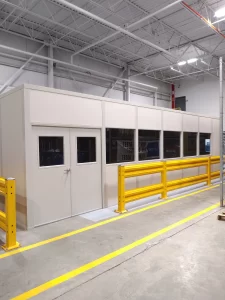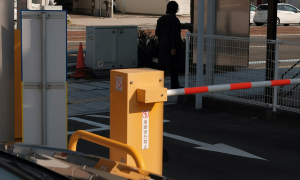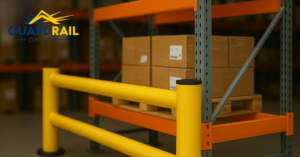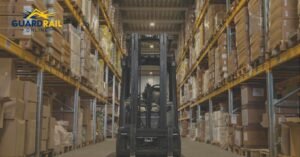Did you know? According to the Occupational Safety and Health Administration (OSHA), over 20% of warehouse-related injuries each year are linked to poor or outdated safety infrastructure. Delayed replacement of damaged or weakened barriers, especially forklift guardrail in Dallas, plays a direct role in many of these incidents.
A compromised forklift guardrails will never be able to offer the save level of protection like a new, robust barrier. These safety systems can cause equipment loss, injuries, or operational shutdowns even after taking one more hit in your warehouse. But these accidents could be avoided if timely action was taken against your compromised or damaged warehouse barrier. That is why guardrail replacement should never be treated as an afterthought.
Forklift guardrails are an essential safety feature that serves as more than just visual boundaries. They serve as critical safety components that absorb force, guide vehicle movement, and separate pedestrian zones from machinery traffic. However, like any industrial safety system, they have a lifespan. Performing minor patches after their end of cycle or after a major collision is often not enough or even sustainable. Moreover, you may be exposing your workforce and assets to unnecessary risks by operating with outdated or deteriorating barriers.
Understanding when to replace a forklift guardrail in Dallas can protect your operations, reduce long-term costs, and bring peace of mind to your daily workflow. But how would you know if it’s time for a replacement? Here are 5 signs to always be on lookout for.
Severe Corrosion and Rust That Goes Beyond the Surface
At first, rust might just look like harmless orange spots on your forklift guardrail in Dallas. But don’t be deceived by surface-level signs. When corrosion begins to take hold beneath the surface, it stops being a cosmetic issue and becomes a serious structural threat. Deep rust weakens the metal from within, slowly eating away at its strength. Barrier legs or rails that have been compromised by corrosion may still appear functional. However, in reality, they have lost their ability to handle impact, bear loads, or protect your people and equipment the way they were designed to.
What makes this even trickier is how easy it is to overlook the early warning signs. Flaking metal, bubbling under the paint, or long brown streaks down the legs can go unnoticed until the damage is already advanced. Once rust causes pitting or holes in the metal, it’s no longer something you can fix with a quick patch. At that point, replacement is the only safe option.
Trying to cover up corrosion with a coat of paint or a quick surface treatment might feel like a quick win, but it usually does more harm than good. Trapped moisture under those coatings can actually speed up the rusting process. That’s why the best move is to replace the affected barrier sections altogether when corrosion reaches a certain point. Swapping in new galvanized or polymer-coated safety barriers would ensure better resistance to moisture. They would also add years of durability and restores the full protective function of your system.
Rust often works quietly and slowly, but its effects can show up all at once, especially during a collision when you need your barriers to perform. At the end of the day, replacing heavily corroded forklift guardrail in Dallas isn’t just about maintaining appearances. It is actually about protecting your workers, your inventory, and the overall safety of your operations. The peace of mind that comes from knowing your barriers are structurally sound is worth far more than the cost of putting off a replacement.
Fractured or Broken Sections That Can’t Be Trusted Again
A safety barrier that’s already cracked or split has done its job once, twice, or even multiple times. However, it may not survive the next impact. Your forklift guardrail in Dallas will not be able to offer the same level of protection as the brand-new alternative once it has snapped or cracked. Even if it is patched or welded, the original strength and energy-absorbing ability are permanently compromised. A repaired fracture might seem stable, but it cannot handle force the way a new section can.
The real danger with fractured guardrails is unpredictability. Relying on temporary fixes creates a false sense of security, which can prove dangerous during heavy operations. They might stand fine one moment and collapse under pressure the next. That same damaged section may fail instantly during a future collision, putting workers, equipment, and inventory at risk.
The smarter move is to replace the broken section entirely. Factory-engineered replacements ensure the structure can redirect impact and meet OSHA compliance. They also guarantee the same load-bearing capacity as the original system. Moreover, if one section failed under impact, there are high-chances that the nearby sections may also have been weakened. Replacing the broken part gives you a chance to inspect and reinforce the entire setup. At the end of the day, it is not just about fixing what broke. It is actually about restoring confidence in your safety system and making sure your warehouse stays protected.
Wear and Tear That Crosses the Line of Safe Usage
Every forklift guardrail in Dallas is built with specific performance limits. These limits define how much impact it can absorb and how often it can absorb that impact. Over time, barriers are bound to take a beating, especially in busy zones. They will absorb hits from forklifts, carts, and pallets regularly. Eventually, those repeated bumps will wear the structure down. What starts as reliable protection would end up turning into a weakened defense.
But it doesn’t happen silently. You and the workers around are going to notice signs. Maybe the metal of the safety barrier feels loose. Maybe the polymer material begin to look dry, cracked, or hardened. Or perhaps the base may have shifted out of alignment. These are not minor signs of wear. They are actually alerts that your warehouse barrier has gone beyond its designed safety threshold. Continuing to repair the same section over and over will only delay the inevitable.
Replacing the worn-out section is the right step forward in such situations. It ensures that all parts of your safety system perform equally. Uniform strength across your barriers will help workers and forklift operators know what to expect during contact. It will also help avoid situations where one barrier reacts differently and puts the entire operation at risk. Replacing based on wear history is not wasteful. It is proactive safety planning. It also reduces the risk of failure during peak operations and keeps your warehouse functioning at full capacity.
Outdated Barriers That No Longer Serve Their Purpose
The environment and layout of warehouses evolves constantly. Equipment gets upgraded. Aisles are widened or rerouted. But too often, one thing stays the same. Your old, weary, forklift guardrail in Dallas. An outdated barrier that was installed years ago might no longer be the right fit for today’s warehouse needs. In fact, it may be holding your operations back more than you realize.
Older guardrails might be too short for today’s pallet stacks. They might not provide coverage for newly designated traffic lanes. Perhaps, they could lack the flexibility required for tighter turns and faster movement in high-traffic zones. What once offered reliable protection might now be a hazard due to misalignment or obstruction.
This is where upgrades become necessary. Replacing outdated warehouse barrier with modular or flexible systems allows you to customize protection to your current layout. Newer designs offer better impact absorption, higher visibility, and more adaptable spacing. All this eventually leads to smoother workflows and fewer disruptions. It also ensures that your safety barriers work with your operations, not against them.
Holding onto an outdated forklift guardrail in Dallas is not a cost-saving move. It is a potential safety compromise. Keeping your safety system in sync with your facility’s needs is key to preventing accidents and keeping operations efficient.
End-of-Life Recommendations You Shouldn’t Ignore
Every forklift guardrail in Dallas has a life cycle. Many manufacturers even define how long their products can safely perform under regular warehouse conditions. This recommended lifespan often ranges between five and ten years. It however depends on the material, impact frequency, and exposure to elements like moisture or chemical spills. Sometimes your forklift guardrail in Dallas may still look fine even at the end of their service life. But that does not mean it is still safe.
Structural reliability is bound to begin to gradually decline, even if the guardrail looks fine from the outside. Internal wear, stress from repeated impacts, and unseen corrosion can all weaken a barrier without showing on the surface. Continuing to use a guardrail past its end-of-life window would moreover increase the risk of sudden failure. It will also raise liability concerns. Eventually, if an accident occurs and your barrier is out of date, the responsibility could all fall on the facility, leaving you with losses and liabilities.
Replacing barriers according to manufacturer guidelines is not being overly cautious. It is being prepared. Newer models are often stronger, more durable, and come with updated features that improve safety and compliance. Regular upgrades ensure that every inch of your warehouse meets current standards and protects both your team and your assets. Following replacement timelines are not a suggestion. It is actually a core part of building a proactive, compliant, and safe work environment.
Conclusion
A facility that prioritizes its safety systems is one that earns trust, stays compliant, and reduces downtime. Moreover, investing in modern, high-performance forklift guardrail in Dallas is not just proactive. It is actually essential in a busy warehouse environment. But when it comes to making that investment, you need a partner you can count on.
That’s where Guardrail Online comes in. We are known for our industry-grade materials, smart modular designs, and decades of expertise. Our company strives to deliver warehouse barriers that are reliable, OSHA-compliant, and built for the demands of your facilities. From expert guidance to fast delivery, Guardrail Online ensures your forklift guardrail replacements are handled with care, quality, and complete safety assurance.





